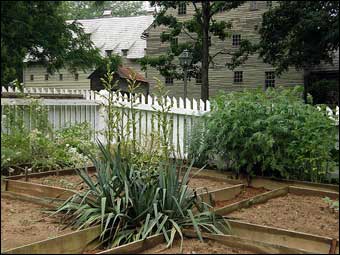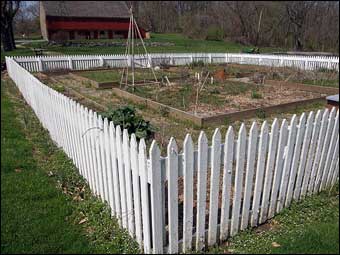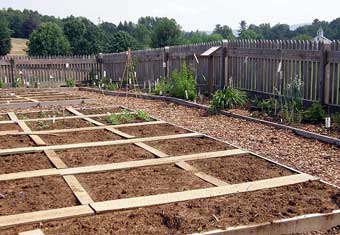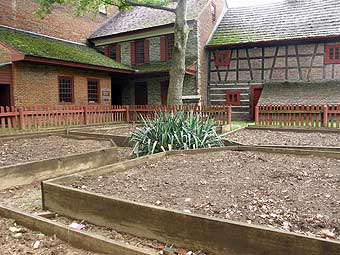
Foursquare garden at Renfrew Museum and Park, Waynesboro
It was a concept in gardening brought over by the colonial Pennsylvania Germans in 1683, but originally was designed by residents of Swiss cloisters and monasteries. The gardens were laid out in multiples of eleven feet with the most common size being fifty-five or sixty-six feet. This was because the length of an eighteenth century fence panel was eleven feet. The surrounding fence in a foursquare garden was composed of two posts, two rails, and pickets which were fifty-two to sixty inches high. The twelve foot rails were made of chestnut which fit into chestnut or locust posts. The flat side of the rail was placed on the outside of the garden. The pickets were of white oak, pine, chestnut, and rarely black walnut split or sawn wood which was nailed at intervals of no more than one and one-half inches.

Foursquare garden at Ephrata Cloisters in Ephrata, Pennsylvania
In the plot plans of a country homestead, the four square garden used the benefit of the morning sun by being placed on the southern or eastern slope of the property. Gardens were very close to the house and sometimes placed jut outside the kitchen door for easy access to the garden crops. A lilac bush was commonly placed on the edge of a four square garden.

The Pennsylvania Germans were meticulous on the planting of crops in the raised beds. There was never any sign of weeds. Annual vegetables grew in straight rows. Flowers could be placed throughout the garden but were commonly at the intersection of where the two paths crossed. There was a small area for herbs which was near the kitchen door. Perennials were relegated to a three-foot-wide perimeter just inside the fence.
In the foursquare garden, the women in the household were the primary gardeners. Whether it was the mother, the daughters, or the hired girl, they were responsible for planting, weeding, watering, and harvesting. The wife determined the time to water and weed, the days for digging and raking, the days of planting, and the days to harvest the crops. She was responsible for two crops a year such as cucumbers, tomatoes, sweet peas, lettuces, spring onions, radishes, carrots, peppers, eggplants, radishes, and melons. Many women painstakingly grew their own seed such as onion sets. The first year's crops was planted to produce seed. The following year the onions were sown in short rows to produce onion sets. After the onions were harvested and dried, they were placed in the ground the final year to grow onion crop. In September a late variety of lettuce was sowed. In winter months for protection the lettuce was covered up by brush and harvested in early spring.

Another scene of the Foursquare garden at the Ephrata Cloisters
During the long winter months, the foursquare garden became the storage area for all the vegetables and some fruits that were produced during the summer months. Cabbage was not only used as sauerkraut, but was also kept fresh by pulling the heads from the ground, roots intact, and removing outer and damaged leaves. The cabbage heads and roots were then packed in a half-barrel buried in the garden. The barrel would then be covered with straw and garden soil. The family could served a fresh cabbage dish if the ground would unthaw during a warm spell. Apples, red beets, and turnips were stored in the same manner.
Since food was such an importance in the Pennsylvania German community, exact rules for planting, harvesting, and weeding were followed. The phases of the moon were followed closely. If seeds were planted in the wrong side of the moon less seeds would bloom. It was a good omen to plant flower seeds during the occurrence of a rainbow.

Some of the most basic tools that were used in a foursquare garden were a shovel, iron rake, spade, wheelbarrow, dung fork, a broad and tined hoe, and sharp knife or heavy shears. A watering can was essential and hung upside down on every fence.
Annual vegetables were planted in rows running north and south to allow the morning sun to shine on one side and the afternoon sun on the other. Beans and cucumbers were planted in hills, and onions were planted in two-foot-wide rows that were marked with the back of a wooden rake.
Be sure to check out the grand opening celebration of Renfrew Institute's Pennsylvania German foursquare garden. The event will feature garden activities for children, a brief program with ceremonial planting, music, and refreshments. Admission is free.
"As students plant seeds, water, care for and harvest the bounty of the 4-square garden,” said Sherry Hesse, institute director of cultural studies, “they also learn concepts in historic preservation, farmstead culture, folklore, plant biology, natural history, ecology, and environmental awareness."

Foursquare garden at the Golden Plough Tavern in York, Pennsylvania. Due to all the rain this year, they are slightly behind in planting the garden.
"I am helping because I believe in their mission here at Renfrew Institute," she said. "Coming to the garden was a wonderful experience for the children."
The garden project was made possible through a grant from the PA Department of Community & Economic Development (DCED) and through the sponsorship of several businesses and individuals: James Rock and GRC Contractors, the late J. Edward Beck, Paul K. and Anna E. Shockey Family Fund, and an anonymous donor. In addition, Rep. Todd Rock and his staff assisted with the DCED grant, and contributions were made by Brian Stum and B & D Lawn and Landscape Inc., John Frantz, Andy Gehr, Matt Gunder, Debbie Pflager, Wayne Martz, David H. Martin, Red Mohn, Chad Otis, and members of the board and staff of Renfrew Institute and Renfrew Museum and Park.
Parking is available in Renfrew’s lower lot off Welty Road. For more information, please call the institute at 717-762-0373 or visit the Renfrew Institute.Source: Text & photos by Bryan Wright



